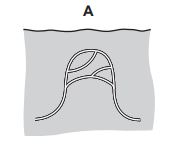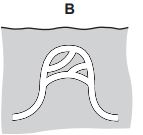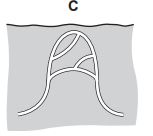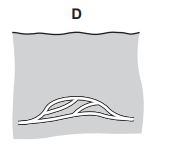The diagram shows a capillary loop in the skin of a mammal.
What will the capillary loop look like if the mammal becomes cold?

Homeostasis-2
Quiz
•
Biology
•
10th - 11th Grade
•
Hard
resmi ragenth
Used 44+ times
FREE Resource
5 questions
Show all answers
1.
MULTIPLE CHOICE QUESTION
30 sec • 1 pt

The diagram shows a capillary loop in the skin of a mammal.
What will the capillary loop look like if the mammal becomes cold?




2.
MULTIPLE CHOICE QUESTION
30 sec • 1 pt

What would be the effects of vasodilation and sweating on the body temperature and on the amount of moisture on the surface of the skin?
A
B
C
D
3.
MULTIPLE CHOICE QUESTION
30 sec • 1 pt
During a long race, an athlete’s skin temperature rises. What causes this?
A increased sweating
B opening of the pores in the skin
C vasoconstriction of the blood vessels in the skin
D vasodilation of the blood vessels in the skin
4.
MULTIPLE CHOICE QUESTION
30 sec • 1 pt
Read the following sentence. In order to prevent the human body from losing heat, the arterioles supplying the skin become narrow.
Which process does this sentence describe?
A constriction
B shivering
C sweating
D vasodilation
5.
MULTIPLE CHOICE QUESTION
30 sec • 1 pt

When the body temperature rises above 37 °C, which changes help to return the temperature to normal?
A
B
C
D

5 questions
Homeostasis II
Quiz
•
10th - 11th Grade

10 questions
Higher Biology Unit 2. KA4: Metabolism in C&R
Quiz
•
11th Grade

9 questions
21 REVIEW: BOOK IMMUNITY
Quiz
•
11th Grade

9 questions
Control Systems of the Body Homeostasis
Quiz
•
11th - 12th Grade

9 questions
Homeostasis Vocabulary
Quiz
•
11th - 12th Grade

10 questions
Body Defence Mechanisms
Quiz
•
11th Grade

9 questions
Homeostasis
Quiz
•
10th - 12th Grade

10 questions
Warm-blooded vs. Cold blooded
Quiz
•
9th - 12th Grade

15 questions
Multiplication Facts
Quiz
•
4th Grade

25 questions
SS Combined Advisory Quiz
Quiz
•
6th - 8th Grade

40 questions
Week 4 Student In Class Practice Set
Quiz
•
9th - 12th Grade

40 questions
SOL: ILE DNA Tech, Gen, Evol 2025
Quiz
•
9th - 12th Grade

20 questions
NC Universities (R2H)
Quiz
•
9th - 12th Grade

15 questions
June Review Quiz
Quiz
•
Professional Development

20 questions
Congruent and Similar Triangles
Quiz
•
8th Grade

25 questions
Triangle Inequalities
Quiz
•
10th - 12th Grade